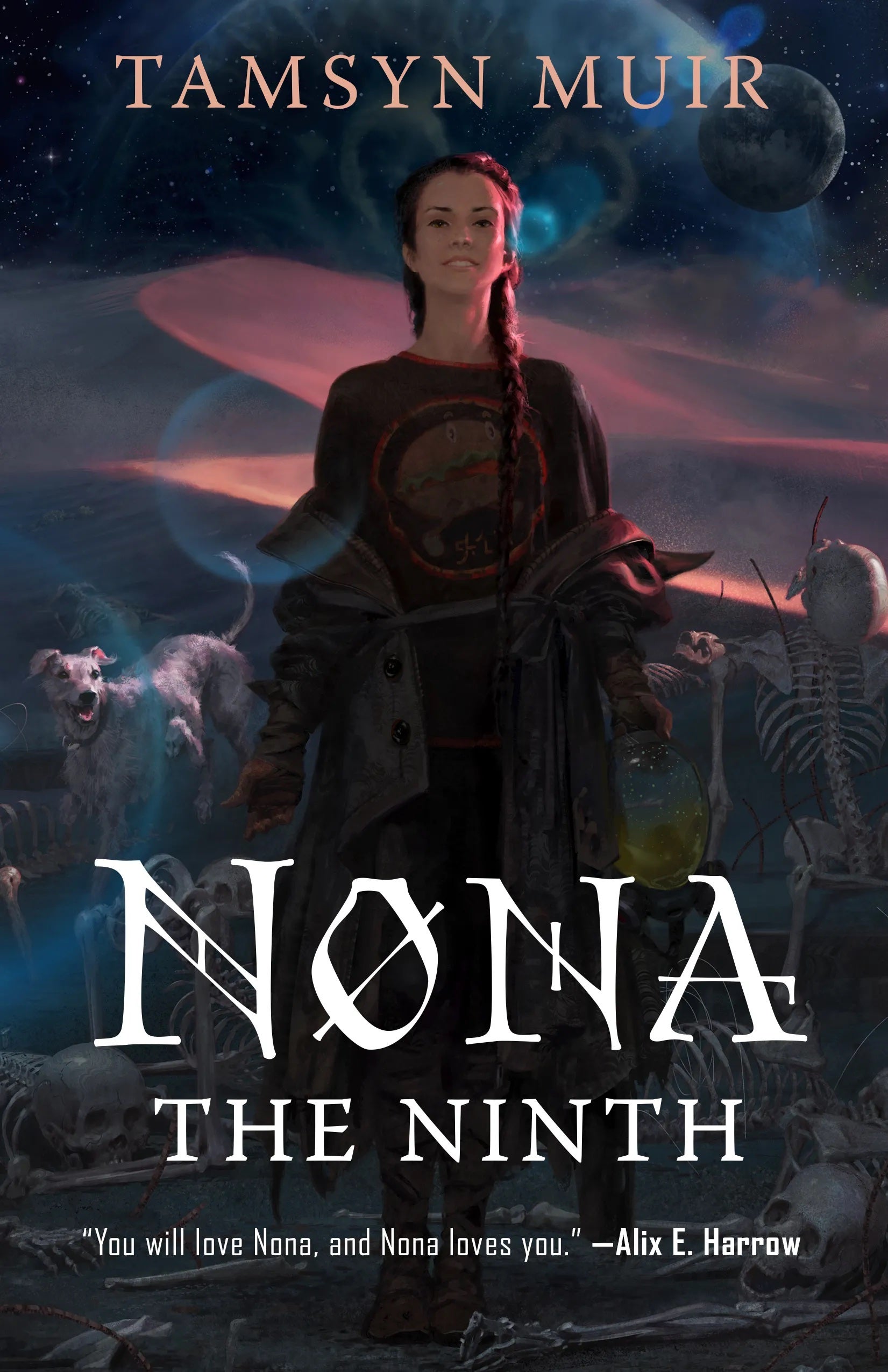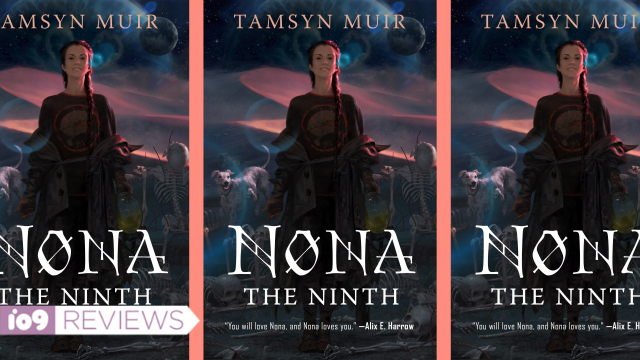Trying to describe the Locked Tomb series is an exercise in asking yourself where to start. Tamsyn Muir’s breakout books are brutally absurd and lyrical, strangely evading these kinds of explanations, but I’ll give it a go.
The first book — Gideon the Ninth — is a haunted house murder royale where God is testing out the capabilities of body alchemists and swords masters in the hope of creating the uber-Saint: capable of miracles and still able to swing a sword really well. Book two — Harrow the Ninth — is about meeting God (whose name is John), travelling through space to find a metaphysical dead person river in order to train Saints to destroy big, planet-eating monsters. It’s part chamber play, part soap opera amnesia storyline, and a lot of the book is spent retelling the first book, but now with memory fuckery.
The third book is about waiting for something else to happen. Nona the Ninth is an intermission. A breath of dead air that stagnates and smells faintly of mould. Some people are going to love it. Some people, like me, are going to slog through it, hoping that there’s some kind of payoff at the 300-page mark (like Harrow the Ninth’s big reveal, which helped ease the painful pace of the first three-quarters of the novel) where things come together. For me, at least, this payoff never happened.
Nona the Ninth follows a character named Nona, who has woken up in the body of Harrowhark Nonagesimus, and who knows and remembers nothing. She acts and thinks like a child, and exhibits few, to none, of the magical necromantic powers of Harrow. Most of the book is spent with Nona as she goes to school with a group of actual children, or with Nona as she sits in various rooms and listens to other people talk. She is a character without agency and without much characterization beyond her childlike naivete. Her greatest redeeming quality is that she tells people she loves them, but even then it feels hollow. It’s love like a child loves a toy, like a dog loves its owner. The love Nona expresses is that of convenience and immaturity, and is given out to anyone who shows her an ounce of kindness. It feels, like much of Nona the Ninth, like a placeholder for development which will happen in the next book.
Without any knowledge of the world around her, Nona’s sit-and-stare modus operandi gets more and more frustrating to read as the book goes on, especially for a series like the Locked Tomb, which rewrites its worldbuilding every couple of chapters. (This is, of course, by design. I can read nonlinear recovery narratives into this book the whole day long, but without any sense of progress or even basic agency, I couldn’t bring myself to care for Nona.) There were points where I was so bored by the conversations on the page that I went back and checked how long it had been since Nona spoke. It is not an exaggeration to say that there are multiple interactions between characters that last for 10, 15, 20 pages without Nona doing, or even saying, anything.
Throughout the book there are also short asides as John (God), the first necromancer, explains how he invented necromancy, and what happened to Earth. These sections of the book are presented as a confession, as the truth, or, as accurate as a subjective recollection of truth can be. The problem for me is that for the entire series, one of the themes has been that all truth is just a lie that someone has believed. These sections feel like convenient lies, presented as fact. Beyond feeling kind of unnecessary in the grand scheme of worldbuilding, these chapters result in no real emotional payoff or plot development beyond a vague handwave towards the next book. We get an encyclopedic history of necromancy that feels sad, clinical, and detached. I failed to connect to any of the characters because the style here is so distant and confessional, and John is a rather sanctimonious arse.
Nona knowing nothing and John knowing everything creates an interesting tension between these sections. But nothing ever happens. Nothing connects. Harrow never makes an appearance beyond offhanded mentions in John’s confession, and Gideon shows up for maybe one hundred pages, isn’t a focus, delivers some cute quips, and then we’re done. Anyone hoping for a reunion, sapphic romance, or necromantic space lesbians will likely be disappointed. The things I loved about Gideon the Ninth — the irreverent voice, the absurd action, the magnificently queer pining — have never returned. This time, we don’t even get to read about God and his Saints having a threesome on a dinner table. There’s no self-cannibalising soup either. Within this entire book there are no standout scenes or remarkably disgusting bits of necromancy. The funniest line is (of course) delivered by Gideon literally in the epilogue.
I just wanted so much more, and I know Muir has the ability to give it to me. For the past two books — both Harrow and Nona — it feels as if Muir has looked back at the characters, lore, and voice of the previous book and decided that she’s simply not interested in repeating herself. This lack of series consistency, paired with the fact that both Harrow and Nona’s plots boil down to “a girl with untapped power has memory problems and vaguely remembers her ex,” is, to put it mildly, frustrating.
One of the things I admire about Muir’s writing is her ability to swing for the fences, entirely without any trace of self-consciousness or restraint, and often flying in the face of conventional narratives. Harrow the Ninth, you may remember, has an incredibly experimental second person POV. However, Nona the Ninth is an exercise in over-developing what should have been a single arc into a novel-length aside. The problem I’m running into with this series is that every book has not only had a new character perspective, but has essentially featured characters that know nothing, each book essentially starting the series over. Gideon is a himbo, and for the first book in a series, it worked. In Harrow the Ninth, Harrow’s memories are locked away and she retells the first book in asides that write Gideon out of the narrative. Now, in Nona, we are starting over again with a new character who knows nothing, and who is essentially a passenger delivering a body to a tomb in anticipation of the final book, Alecto the Ninth.
This book does include some great lyrical turns of phrase and running jokes. It dives into misery and hurt and doesn’t look away. It talks about grief, death, sacrifice, and depression with an expansiveness that is incredible and unmatched. But for all these benefits, Nona has none of their grace. This book brushes against these emotions that can get caught in your throat but then moves on before they catch. It’s these moments where the writing is funny, insightful, brash, and unapologetic that pushed me to keep reading. Maybe in 20 pages I would get more, or something great would happen, or Nona would develop. And for me, it never did. I would read these singular moments of cleverness that simply existed, untethered, as the narrative continued to be explained to me.
As the third book in a series, Nona the Ninth is already getting a lot of hype from die-hard fans of the Locked Tomb series. But this is a book that would make me tell fans not to bother. I feel like, ultimately, by book three of a quartet, I should care about the main characters. I feel like I should be invested in their story, struggles, and character development and world. But there simply isn’t enough to Nona to latch onto. Muir has said herself that this was originally supposed to be act one of Alecto the First, and frankly, I wish it had been 100 pages instead of 400. Winks at memes, Aussie humour, the occasional dirty joke and poignant metaphor are all good in the moment, but without narrative edges, every part of this book bleeds into one long conversation interrupted by small movements, like a twitching corpse going into the last stages of rigour mortis.

Nona the Ninth is available to purchase on September 13; you can order a copy here.
Want more Gizmodo news? Check out when to expect the latest Marvel and Star Wars releases, what’s next for the DC Universe on film and TV, and everything you need to know about House of the Dragon and Lord of the Rings: The Rings of Power.
Editor’s Note: Release dates within this article are based in the U.S., but will be updated with local Australian dates as soon as we know more.
